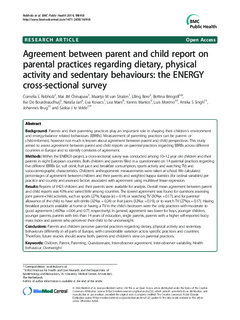| dc.contributor.author | Rebholz, Cornelia E | |
| dc.contributor.author | ChinAPaw, Mai JM | |
| dc.contributor.author | Van Stralen, Maartje | |
| dc.contributor.author | Bere, Elling | |
| dc.contributor.author | Bringolf, Bettina | |
| dc.contributor.author | De Bourdeaudhuij, Ilse | |
| dc.contributor.author | Nataša, Jan | |
| dc.contributor.author | Kovacs, Eva | |
| dc.contributor.author | Maes, Lea | |
| dc.contributor.author | Manios, Yannis | |
| dc.contributor.author | Moreno, Luis | |
| dc.contributor.author | Singh, Amika S | |
| dc.contributor.author | Brug, Johannes | |
| dc.contributor.author | te Velde, Saskia J. | |
| dc.date.accessioned | 2014-10-01T11:44:32Z | |
| dc.date.available | 2014-10-01T11:44:32Z | |
| dc.date.issued | 2014 | |
| dc.identifier.citation | Rebholz, C., Chinapaw, M., van Stralen, M., Bere, E., Bringolf, B., De Bourdeaudhuij, I., . . . te Velde, S. (2014). Agreement between parent and child report on parental practices regarding dietary, physical activity and sedentary behaviours: the ENERGY cross-sectional survey. BMC Public Health, 14(1), 1-15. doi: 10.1186/1471-2458-14-918 | nb_NO |
| dc.identifier.issn | 1471-2458 | |
| dc.identifier.uri | http://hdl.handle.net/11250/222604 | |
| dc.description | Published version of an article from the journal: BMC Public Health. Also available from the publisher: http:/dx.doi.org/10.1186/1471-2458-14-918 | nb_NO |
| dc.description.abstract | Background: Parents and their parenting practices play an important role in shaping their children’s environment
and energy-balance related behaviours (EBRBs). Measurement of parenting practices can be parent- or
child-informed, however not much is known about agreement between parent and child perspectives. This study
aimed to assess agreement between parent and child reports on parental practices regarding EBRBs across different
countries in Europe and to identify correlates of agreement.
Methods: Within the ENERGY-project, a cross-sectional survey was conducted among 10–12 year old children and their
parents in eight European countries. Both children and parents filled in a questionnaire on 14 parental practices regarding
five different EBRBs (i.e. soft drink, fruit juice and breakfast consumption, sports activity and watching TV) and
socio-demographic characteristics. Children’s anthropometric measurements were taken at school. We calculated
percentages of agreement between children and their parents and weighted kappa statistics (for ordinal variables) per
practice and country and assessed factors associated with agreement using multilevel linear regression.
Results: Reports of 6425 children and their parents were available for analysis. Overall mean agreement between parent
and child reports was 43% and varied little among countries. The lowest agreement was found for questions assessing
joint parent–child activities, such as sports (27%; Kappa (κ) = 0.14) or watching TV (30%;κ = 0.17), and for parental
allowance of the child to have soft drinks (32%;κ = 0.24) or fruit juices (32%;κ = 0.19), or to watch TV (27%;κ = 0.17). Having
breakfast products available at home or having a TV in the child’s bedroom were the only practices with moderate to
good agreement (>60%;κ = 0.06 and 0.77, respectively). In general, agreement was lower for boys, younger children,
younger parents, parents with less than 14 years of education, single parents, parents with a higher self-reported body
mass index and parents who perceived their child to be underweight.
Conclusions: Parents and children perceive parental practices regarding dietary, physical activity and sedentary
behaviours differently in all parts of Europe, with considerable variation across specific practices and countries.
Therefore, future studies should assess both, parents and children’s view on parental practices. | nb_NO |
| dc.language.iso | eng | nb_NO |
| dc.publisher | Biomedcentral | nb_NO |
| dc.rights | Navngivelse 3.0 Norge | * |
| dc.rights.uri | http://creativecommons.org/licenses/by/3.0/no/ | * |
| dc.title | Agreement between parent and child report on parental practices regarding dietary, physical activity and sedentary behaviours: the ENERGY cross-sectional survey | nb_NO |
| dc.type | Journal article | nb_NO |
| dc.type | Peer reviewed | nb_NO |
| dc.subject.nsi | VDP::Medical disciplines: 700::Health sciences: 800::Nutrition: 811 | nb_NO |
| dc.source.pagenumber | 15 p. | nb_NO |
| dc.source.volume | 14 | nb_NO |
| dc.source.journal | BMC Public Health | nb_NO |
| dc.source.issue | 1 | nb_NO |
| dc.identifier.doi | 10.1186/1471-2458-14-918 | |

